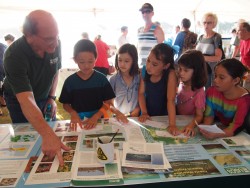Earth Day Offers Environmental Education
Molokai’s natural resource managers, biologists and those engaged in preserving Molokai’s environment turned their projects into fun and engaging information to share with hundreds of attendees at Molokai’s annual Earth Day Celebration last Friday.
“I’ve always said, our science is only valuable if shared with others,” said Jim Jacobi, an ecosystems research biologist with the U.S. Geological Survey (USGS) who has been participating in Molokai’s Earth Day celebration for more than five years. “I tell people, ‘If you want to go to Earth Day, go to Molokai!’ People here are relaxed and interested. We need to make science understandable.”
That was the goal of dozens of organizations that showcased their work at the event’s booths. Earth Day organizers took the education a step further by incentivizing youth and adults alike to interact with presenters. Attendees were given stamp cards, and each colorful stamp represented information gained from different booths. Once cards were filled up, they could be entered into the drawing for prizes like a new bicycle or a dry box.
“We’re trying to study vegetation and why there’s mud on the reef,” Jacobi explained to eager keiki leaning over a map showing his work in Kawela. After engaging in conversation with them and answering some questions, he gave them each a stamp on their papers.
For a group launching a volunteer efforts to remove invasive gorilla ogo seaweed that is overtaking Molokai’s reefs, Earth Day was an opportunity to bring their project to the public for the first time. With over half a dozen local and government agencies already in support, Office of Hawaiian Affairs trustee Colette Machado encouraged residents to sign up to participate in a gorilla ogo survey and assist in the control and removal of the seaweed, a movement spurred by an extensive science fair project launched by a group of Molokai high students.
“What began as a concern is now at a crisis level,” Machado said of gorilla ogo. “Now we’re trying to get agencies reach out to fishermen, paddlers and divers [and other community volunteers]… There’s no funding so we have to rely on the human spirit.”
The Hawaii Tropical Fruit Growers Molokai chapter members gave attendees samples of dried soursop, a large fruit with green skin covered in soft thorns and white, smooth flesh. The Molokai Land Trust challenged passersby to identify a variety of plants as native or non-native, including the lama tree, a native persimmon. Its name means “light” in Hawaiian, according to Land Trust Executive Director Butch Haase, because its wood was used historically to make signal fires, as evidenced by remnants of charcoal found near the Kalaupapa trail.
Along with sharing information, Earth Day is also an opportunity to acknowledge outstanding contributions to conservation in the community. Environmental educator Penny Rawlins Martin was honored with this year’s Malama Kuleana Honua award. Martin was one of the Hokulea’s original crewmembers in 1976, and she said the journey from Tahiti to Hawaii taught her many lessons about valuing the environment and working together to preserve our ecosystem. Since then, she has volunteered countless hours at various schools and organizations to share aloha aina with youth and her island.
“We cannot thank Penny enough for everything she has done and continues to do for our community and for Molokai,” The Nature Conservancy’s Wailana Moses wrote in the organization’s Molokai newsletter. “Penny is truly a living treasure.”
Martin said while it feels good to be honored, there are many others who also deserve to be recognized.
“They say I do all this good work but there are so many people that help me; I don’t do it by myself,” she said. “I’m so appreciative of them… We live on an island where everyone cares about our island and works hard for our island.”













Don't have a Molokai Dispatch ID?
Sign up is easy. Sign up now
You must login to post a comment.
Lost Password